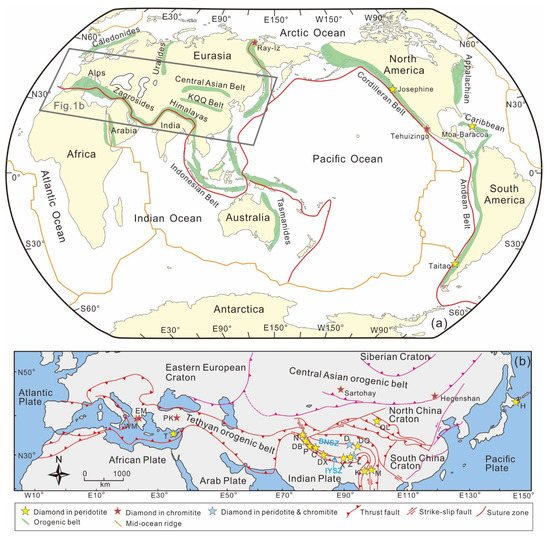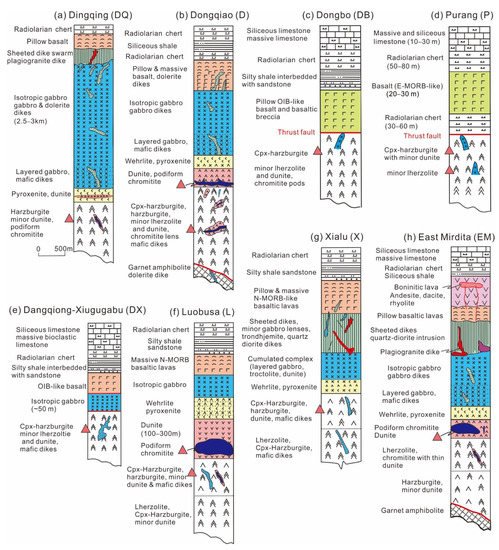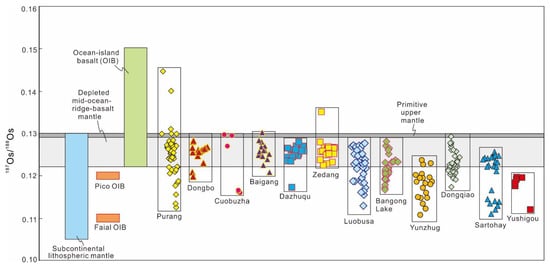1. Introduction
According to the differences in occurrence and genesis, natural diamonds are divided into various types, including diamonds occurring in kimberlite, lamproite, ophiolite, alkaline mafic rock, crust-derived ultrahigh-pressure (UHP) metamorphic rock, meteorolite-related and alluvial rocks
[1][2][3][4][5]. Ophiolites are fragments of ancient oceanic crust and upper mantle, which is created at ocean spreading ridges and then emplaced on land
[6]. Ophiolite-hosted diamond discovered in ophiolitic peridotite and chromitite is considered to be a new type that has been named an ophiolite-type in recent years
[4][7].
It has been hundreds of years since the first discovery of diamonds in ophiolites
[8][9][10]. Diamonds were successively discovered in ophiolites from Quebec in Canada
[8], Kamenusha in the Urals (Russia) and Koryak in the Far East
[9][10]. However, these early stage studies merely reported the occurrence of diamonds in ophiolites but did not systematically relate these discoveries to plate tectonics. Since the 1980s, the diamond group in the Chinese Academy of Geological Sciences discovered diamonds in the Luobusa ophiolite (also named Qusong) in the Indus-Yarlung Zangbo suture zone (IYSZ) and Dongqiao ophiolite in the Bangong Nujiang suture zone (BNSZ) in Tibet, China
[11][12][13][14]. Subsequently, Jingsui Yang and his group continued this research, and diamonds were also discovered in the ophiolites of Luobusa, Purang, Dongbo, Dangqiong and Dingqing in Tibet, Sartohay in Xinjiang, Hegenshan in Inner Mongolia, Myitkyina and Kalemyo in Myanmar, Pozanti-Karsanti in Turkey, Mirdita in Albania and Horoman in Japan
[15][16][17][18][19][20][21][22][23][24][25][26][27][28][29][30][31][32][33]. As these diamonds were extracted by heavy mineral separation in the early stage, their natural origin was initially doubted
[7][34]. However, it was not until the in situ diamonds were discovered in the Luobusa and Polar Ural chromitites as well as the Nidar mantle peridotites
[24][35]. Particularly, ophiolite-hosted diamonds have inclusions of fluid and Mn-Co-Ni alloy and obviously show trace elements, e.g., Ba, Pb, Th and Eu, and crust-derived carbon–nitrogen isotope compositions different from those of synthetic diamonds
[5][36][37]. Following the independent discovery of diamonds in ophiolitic mantle peridotites and chromitites by Australian, Spanish and Indian geologists, the occurrence of the ophiolite-type diamond was widely accepted
[35][36][38][39].
Ophiolite-hosted diamond and other UHP minerals have been globally discovered in ophiolites from various orogenic belts, suggesting that diamonds are widespread in mantle rocks
[5][24][37][40]. The discovery of ophiolite-hosted diamond opens a new field for research on the genesis of ophiolitic chromitite and host mantle peridotite and for the exploration of the dynamics of crust–mantle recycling
[41][42][43]. However, the amounts of diamonds extracted from various ophiolitic peridotites and chromitites differ greatly. For most massifs, several diamond grains were recovered per ton, while over one thousand diamond grains per ton were discovered from the Luobusa mantle peridotites and chromitites. In contrast, less than ten diamond grains per ton were recovered from mantle peridotites in the Xialu (Xigaze), Zedang, Dongbo and Myitkyina massifs
[40][44]. It is still unclear what contributes to the difference in such diamond concentrations. A discussion of the spatial distribution and formation mechanism of ophiolite-hosted diamond has become a new direction of current research of ophiolites and plate tectonics
[5][37][40]. This paper summarizes the geological characteristics of diamond-bearing ophiolites and discusses the four genetic models for the diamond-bearing and associated unusual minerals-bearing ophiolites, providing a basis for discussing the formation of ophiolitic chromitite and the dynamic process of crust–mantle material recycling.
2. Global Distribution of Diamond-Bearing Ophiolites
Twenty-five diamond-bearing ophiolites have been discovered across the globe, and they are mainly distributed along the Tethyan Orogenic Belt, the Ural-Central Asian Orogenic Belt, the Hidaka metamorphic belt, the Klamath–Acatlán Orogenic Belt in North America and the Andean Orogenic Belt in South America (
Figure 1a). The Tethyan Orogenic Belt is a giant and long-lived plate subduction–collision system on the earth that separates the Gondwana supercontinent to the south from the Laurasia supercontinent to the north
[45]. It displays a structural difference of continent–continent collision alternating with ocean–continent subduction from east to west (
Figure 1b). This belt extends from the Alpine continent–continent collisional orogenic belt in Europe via the complicated Mediterranean ocean–continent subduction belt, eastwards to the Zagros continent–continent collisional orogenic belt in West Asia and the Makrun ocean–continent subduction belt to the east, and to the Himalayan continent–continent collisional orogenic belt. Then it connects with the ocean–continent subduction zone formed by East Indian oceanic slab subducting below Southeast Asia
[46]. The Tethyan Orogenic Belt represents an oceanic system remnant commonly composed of Prototethyan, Paleotethyan and Neotethyan oceans that developed during the Early Paleozoic, Late Paleozoic and Mesozoic, respectively
[45]. The Paleotethyan ocean represented by late Paleozoic-Triassic ophiolites was bounded by the Cimmerides to the south that mainly consists of Anatolia, Persia, Afghanistan and Tibet, and Cathaysides to the north that includes South China, Indochina, Sibumasu and Qamdo blocks
[45][47][48]. The Neotethyan ocean documents the Mesozoic rifting of Pangea and comprises multiple seaways formed by seafloor spreading and widening eastwards and deep mantle circulation processes, including several stages of slab subduction and mantle plume activities
[49].
Figure 1. Distribution of twenty-five diamond-bearing ophiolites reported on the globe (
a). Nineteen diamond-bearing ophiolites are distributed along the Neotethyan Orogenic Belt, Kunlun–Qilian–Qinling Paleotethyan Orogenic Belt (KQQ), Central Asian Orogenic Belt and Hidaka metamorphic belt (
b). Ophiolites: C—Cuobuzha, D—Dongqiao, DB—Dongbo, DQ—Dingqing, DX—Dangqiong–Xiugugabu, EM—Eastern Mirdita (Albania), K—Kalamyo (Myanmar), L—Luobusa, M—Myitkyina (Myanmar), N—Nidar (Kashmir), P—Purang, PK—Pozanti Karsanti (Turkey), QL—Qilian, T—Troodos, WM—Western Mirdita (Albania), X—Xialu, Z—Zedang. Ural-Central Asian Orogenic Belt: Sartohay, Hegenshan, Ray-Iz (Polar Urals). Hidaka Metamorphic Belt: H—Horoman (Japan). BNSZ—Bangong Nujiang suture zone, IYSZ—Indus Yarlung Zangbo suture zone. Internal structures are modified from
[50][51][52][53].
The Neotethyan Orogenic Belt, which was discovered with fifteen diamond-bearing ophiolites, includes three subbelts of the BNSZ, IYSZ and the Eastern Mediterranean zone (
Figure 1b). Diamond-bearing Dongqiao and Dingqing ophiolites occur in the BNSZ, Tibet
[13][14][27]; the Myitkyina ophiolite is located in the Burmese Eastern ophiolitic belt that is regarded to be the southern continuation of the BNSZ
[54]. The Luobusa, Zedang, Xialu, Dangqiong–Xiugugabu, Purang, Dongbo, Cuobuzha and Nidar ophiolites occur in the IYSZ
[7][14][20][23][25][26][35][55][56][57]; the Kalamyo ophiolite crops out in the Indo-Burma Range that is regarded to be connected with the IYSZ
[58]. The Pozanti Karsanti (Turkey), East Mirdita (Bulqiza, Albania) and West Mirdita (Skenderbeu, Albania) ophiolites occur in the Mediterranean ophiolite belt
[28][30][32] (
Figure 1b).
The 495–550 Ma diamond-bearing Yushigou ophiolite in the North Qilian Orogenic Belt represents the relics of the Prototethyan ocean
[59]. Diamond-bearing ophiolites in the Ural-Central Asian Orogenic Belt consist of the Ray-Iz massif in the Polar Urals
[24], the Sartohay ophiolite in Xinjiang and the Hegenshan ophiolite in Inner Mongolia
[21][22] (
Figure 1b). The diamond-bearing Horoman mantle peridotites
[33], each ~10 km long, ~8 km wide and ~3 km thick, are exposed along the southern edge of the NNW–SSE oriented, ~120 km long and 10~20 km wide Hidaka metamorphic belt, which is the boundary between the North American Plate (Okhotsk block) and the Eurasian Plate
[60]. The Klamath–Acatlán Orogenic Belt includes the Klamath massif in western United States and the Acatlán complex in southern Mexico
[39]. Ophiolite-hosted diamonds in this belt were discovered in the Jurassic Josephine peridotite
[61] and the Early Paleozoic Tehuitzingo chromitite
[39], respectively. About ten diamond grains were discovered in the Moa-Baracoa ophiolitic peridotite massif in eastern Cuba, which is about 100 km long and 10–30 km wide, covering an area of ~1500 km
2 (Rui et al., in preparation). One diamond grain was obtained from the Taitao peridotite in Chile, the western part of the Andean Orogenic Belt (Wu et al., in preparation).
3. Geochemical Characteristics of Diamond-Bearing Ophiolites
The wall rocks of the ophiolite-hosted diamonds are podiform chromitite and mantle peridotite. Mantle peridotite is dominated by Cpx-bearing harzburgite (
Figure 2). Diamond-bearing lherzolite was merely reported in the Purang and Horoman massifs
[33][56]. Ophiolites in the IYSZ, including the Purang, Dongbo, Cuobuzha, Dangqiong, Xialu, Zedang and Luobusa massifs, commonly have harzburgites with low contents of Al and Ca but high contents of Mg relative to the primitive mantle. The REE and Os contents of these harzburgites are notably lower than those of the primitive mantle. These geochemical features are comparable with those of depleted abyssal peridotites, which have experienced variable degrees of partial melting
[62][63]. Some samples are relatively enriched in LREE, Rb and Ba and have a comparatively large range of Cr
# (Cr
# = 100 × Cr/(Cr + Al), 18–75) in chromite (Cr-spinel). The diamond-bearing peridotites commonly show higher contents of platinum group elements (PGE) than those of the primitive mantle. Such geochemical characteristics suggest that these depleted abyssal peridotites were widely metasomatized by sulfide-rich, incompatible element-rich and high-PGE fluids/melts
[62][63][64][65].
Figure 2. Compiled stratigraphic-lithological columnar sections of the main diamond-bearing ophiolites shown in
Figure 1b along the Neotethyan Orogenic Belt. Red triangles labeled as diamonds hosted in podiform chromitite, harzburgite and lherzolite. (
a) Dingqing ophiolite from the eastern part of the BNSZ, Tibet
[27][44]; (
b) Dongqiao ophiolite from the central part of the BNSZ, Tibet
[13][14][44]; (
c) Dongbo, (
d) Purang and (
e) Xiugugabu ophiolites from the wetern part of the IYSZ
[44]; (
f) Luobusa ophiolite from the eastern part of the IYSZ
[14][16][17]; (
g) Xialu ophiolite from the central part of the IYSZ
[26][44]; (
h) East Mirdita (Bulqiza massif) from the eastern Mediterranean ophiolite belt
[28].
In a rock–melt interaction process, Re-Os isotopes can reflect the impacts of infiltrating melts on the ophiolitic mantle
[66][67]. Os is a highly compatible element during partial melting, while Re is a moderately incompatible element, which leads to comparatively low Re/Os ratios and increases the
187Os/
188Os ratio in residual mantle peridotites, although the rate of growth reduces over time
[66][67][68]. Thus, the lower
187Os/
188Os ratios recorded in peridotites may indicate an earlier local melting event
[63][68]. In addition, serpentinization, seafloor alteration and metasomatism of mantle peridotites by fluids/melts pose weak impacts on the whole rock’s
187Os/
188Os ratio, and thus, the Re depletion model ages can reflect the time of partial melting
[67][68]. Compared to the average
187Os/
188Os ratio of a primitive upper mantle (0.1296)
[69], seventy-eight
187Os/
188Os ratios (0.113–0.145, with an average of 0.125) of the Purang, Dongbo and Cuobuzha harzburgites in the western segment of IYSZ overlap the ranges of the subcontinental lithospheric mantle (SCLM, 0.105–0.129)
[70] and depleted oceanic lithospheric mantle (0.123–0.129)
[70][71]. The Baigang and Dazhuqu mantle peridotites in central IYSZ display a relatively large range in
187Os/
188Os (0.118–0.130, with an average of 0.126). Additionally, sixty-eight
187Os/
188Os ratios of Luobusa and Zedang mantle peridotites in the eastern segment show a comparatively large range (0.121–0.137, with an average of 0.126
[63][72][73]. They all show hybrid signatures of depleted oceanic lithosphere and SCLM (
Figure 3).
Figure 3. Osmium isotopic values of diamond-bearing chromitite and peridotite in different ophiolites. Osmium isotopic values of primitive upper mantle, depleted mid-ocean-ridge-basalt mantle, Ocean-island basalt (OIB), Pico and Faial OIB from the Azores after
[71]. Osmium istotopic data references: Purang
[63][74][75]; Dongbo
[62]; Cuobuzha
[65]; Baigang
[63]; Dazhuqu
[76]; Zedang
[63][77]; Luobusa
[72][78][79]; Bangong Lake
[80]; Yunzhug
[81]; Dongqiao
[67][79][82]; Sartohay
[79]; Yushigou
[59].
Podiform chromitite is defined as lenticular aggregates of chromite formed in Alpine-type peridotites and oceanic crust–mantle transition zones
[83], and it normally contains over 20 vol.% chromite, and preserves abundant magma rheological and high-temperature deformation structures that are distinct from those of layered chromitite
[83][84]. Podiform chromitite, by occurrences and Cr values of chromite, may be classified as follows: (1) According to the exposed locations of chromitite orebodies in a well-exposed ophiolitic sequence, ophiolite can be divided into subvarieties occurring below and within the MOHO transition zone
[83][85][86]. The former is mostly enclosed in harzburgite with a thin dunite-envelope and usually occurs as large-sized deposits of economic value. The latter is generally distributed in thin-bedded dunite and usually forms small-sized, disseminated and banded chromitite deposits, which are commonly interlayered with cumulate dunite
[86]. (2) According to the structural deformation features of podiform chromitite orebodies, chromitite deposits are mainly divided into discordant, subconcordant and concordant types compared with permeable structures of foliation and lineation developed in host mantle peridotites
[87]. Discordant ore bodies are irregular and obviously cut through the foliation and lineation of peridotites, subconcordant orebodies usually have angles of 10°–25° with the foliation, and concordant ore bodies are commonly parallel to the foliation and lineation
[87]. (3) According to the chromite aggregation forms, podiform chromitites are divided into massive, nodular, antinodular, densely/sparsely disseminated, banded and vein-like types
[85][88][89]. (4) According to geochemical compositions of chromite in podiform chromitite, it can be divided into high-Cr (Cr
# value > 60) type and high-Al (Cr
# value < 60) type
[90]. High-Al chromitite is usually considered to be precipitated from basaltic melts, which might be formed at a mid-ocean ridge (MOR) or derived from backarc or forearc settings at a suprasubduction zone (SSZ). High-Cr type is generally related to boninitic melt metasomatism in subduction zones
[91][92]. Recently, Li et al. (2019) further subdivided chromitite from the Dingqing ophiolite in the BNSZ, China, into high-Cr (Cr
# = 78–86), medium-high-Cr (Cr
# = 60–74), medium-Cr (Cr
# = 30–51) and low-Cr (Cr
# = 9–14) types
[89].
Ophiolite-hosted diamonds occur in both high-Cr chromitite, e.g., the Ray-Iz and Luobusa ophiolites
[24][93], as well as in high-Al chromitite, e.g., the Sartohay and Hegenshan ophiolites
[21][22]. They even have been recovered from high-Al and high-Cr type chromitites in the same ophiolite massif such as Dongbo, Purang, Dingqing, Mirdita and Pozanti Karsanti
[29][32][89][94]. Current statistics show that the amount of diamond grains in high-Cr type chromitite is much higher than those in high-Al type chromitite
[40]. For example, the number of diamond grains from the Luobusa, Kangjinla and Ray-Iz massive high-Cr chromitites reaches 1000 per ton in total
[20][24][57], while in both high-Al type and high-Al-high-Cr type chromitites from, e.g., the Dongbo and Purang ophiolites, there are commonly only several to dozens of diamond grains per ton
[7][56][95]. The reason for these differences is unclear.
187Os/
188Os ratios of chromitites are significantly higher in high-Cr chromitites compared to high-Al chromitites. For example, for Dongbo and Purang, the high-Cr chromitites have
187Os/
188Os compositions varying from 0.128 to 0.133 and 0.123 to 0.132, respectively, whereas their high-Al chromitites have values ranging from 0.120 to 0.126 and 0.124 to 0.127
[62][63][74][94]. It is noted that compared to the Purang and Dongbo high-Cr chromitites, the Luobusa high-Cr chromitites exhibit generally lower
187Os/
188Os ratios of 0.104–0.127
[72][78][79] (
Figure 3). The latter chromitite massif has been interpreted to have been formed by decompression partial melting of garnet and orthopyroxene (Opx) in the SCLM
[37][79]. Alternatively, the Luobusa podiform chromitite was produced by mixing primitive asthenospheric Cr-rich melt and boninitic magma, triggering the saturation and crystallization of chromite
[96].



